Duda and Squarespace are cloud- and web-based SaaS platforms that allow users to build websites and e-commerce storefronts.
Squarespace is one of the most widely known site builders, and it’s the much more popular platform of the two, as this report clearly shows. But this doesn’t mean that Duda has nothing to offer. On the contrary, it offers a lot of features for diverse types of audiences.
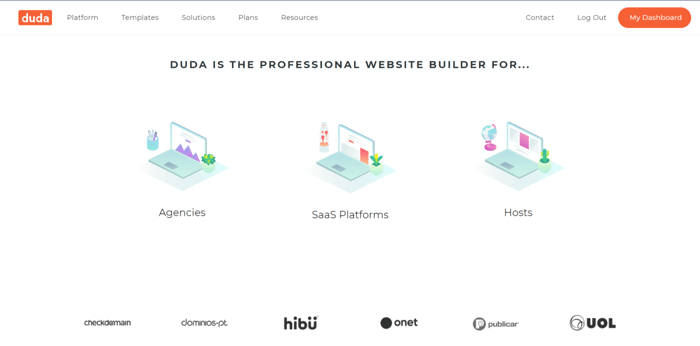
Duda, as a platform that caters to agencies, other SaaS platforms, and hosting companies, as well as regular users, has a slightly different structure than Squarespace. This is reflected in what these two platforms offer and how much of it. For instance, with Duda, you can manage many clients from one dashboard. This client management system is essential for agency owners. Also, unlike Squarespace, Duda offers white labeling, which is one of the must-haves if agencies are part of your target audience.

In this Duda vs. Squarespace comparison, we’ll look at the two platforms closely, explore some of their more important and interesting features, and see what their strong sides and downsides are. So, without further ado, let’s get to it.
Table of Contents
Customer Reviews
Selecting the right site builder, just like any other product, requires research – or at least thumbing through reviews to see what other people think of it and what their experiences are. In this case, it’s totally natural and justified to care about what other people think. Reviews are a good indicator of what you can expect from a product.
Based on customer reviews on Capterra – 207 reviews for Duda and 3,068 for Squarespace – the overall score of both platforms is the same. They both have high ratings and the majority of reviewers are satisfied with their services. However, Duda beats Squarespace in the likelihood-to-recommend category: 82.4% of Duda reviewers would recommend the platform to other users compared to 74.8% of Squarespace reviewers.
Things are a tiny bit different on another credible customer review site, G2, where both platforms fare pretty well. However, based on around 700 reviews, Duda holds slightly better customer ratings compared to Squarespace, which has about 1,000 reviews.
On both review sites, Squarespace has a larger number of reviews. This can be explained by the fact that it’s the more widely known and used platform.
So, from the data derived from two reliable review sites, we can conclude that Duda holds better ratings, but Squarespace is much more used.
Who Are Duda and Squarespace for?
Squarespace
Squarespace is great for regular users and small businesses. It’s also great for newbies and inexperienced users since it’s extremely easy to understand how the platform works and how to do the necessary stuff to build and run a website in a hassle-free way.
Duda
Duda can be tricky, primarily because it’s geared toward agencies and developers too, not just regular users and merchants. As a platform that caters to disparate categories of users and aims to be able to meet everyone’s needs, Duda offers more functionality.
Some of the available tools are a bit hard to understand conceptually and practically. But, as we’ll see in one of the next sections, there are plans for everyone in Duda’s repertoire. This is probably what accounts for the Duda customers being extremely happy with how easy it is to use the platform, despite the not-so-simple tools.
Editor
Duda and Squarespace offer the same type of drag-and-drop visual editor. It’s no wonder that the bulk of site builders and e-commerce platforms provide a drag-and-drop editor: it's an easy-to-use, no-nonsense site editor.
On both platforms, the editor is structured in sections and columns, which limits the possibilities when it comes to placing elements on the page. However, this is not necessarily a downside. This helps you create well-structured, professional-looking sites without ever learning a bit of code or without any web-design background.
Squarespace
Squarespace makes adding new elements easy-peasy. You just need to click one of the pluses, which show you all the possible spots where you can add an element, and you’re done. Then, you can move the element without any problems.
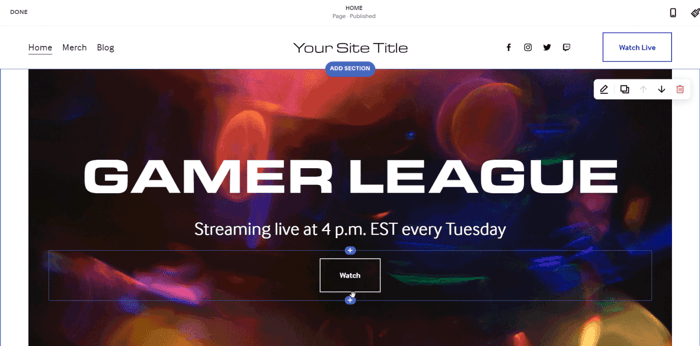
Users can add text, images, buttons, videos, forms, products, member sign-ups, social media icons, new sections, and a lot more.
As you scroll up and down or move your mouse left and right, the pluses and available elements disappear, which can result in tedious repetitive clicking on the page to bring them back. This can be frustrating if you’re editing your site for a longer time, but it’s not that big a deal.
If you change your mind and don’t want to keep the newly-added element, getting rid of it is as simple as clicking the trash can icon. But if you want to keep it and intend to make some alterations regarding style, you just click on the block you want to modify and you’ll see the available customization options.
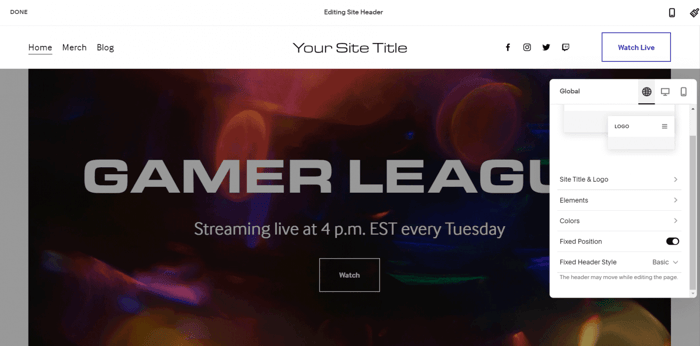
All in all, using the Squarespace editor is a pretty intuitive and trouble-free experience.
Duda
To add an element in the Duda editor, you first need to click the “Widgets” icon and then drag and drop the element you want to add: text, images, icons, sliders, dividers, tables, accordions, coupons, and much more.

As far as placing an element on a page, Duda is a bit clunky. Sometimes, it happens that you just can’t hit the right spot or spots where the editor suggests you put the new element. So you need to try a couple of times before succeeding in placing the element correctly.
Editing elements works the same way as in Squarespace:
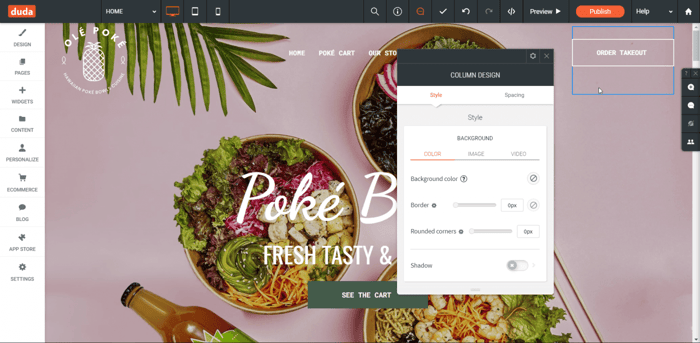
An interesting piece of information about the Duda editor is that it was rebuilt a few years ago. For this process, the developers used the JavaScript library React. It helped them build the faster, more consistent, and more efficient editor we have the opportunity to use today.
The Duda editor is tidy and simple too, but the Squarespace editor is probably a bit simpler to use.
Templates
Squarespace
There’s no shortage of templates in the Squarespace templates store. All the templates are responsive and customizable. They’re divided into different categories according to their type and topic.

Squarespace has a minimalist approach that many would appreciate and like.
When you start building your site, the platform suggests the most relevant templates for the type of site you want to create. This can be very helpful because it can speed up the whole process of building a site. In case you don’t find it useful, you can pick a template yourself. However, Squarespace doesn’t let you switch templates once you’ve started with one.
Duda
Duda offers site/page templates and section templates. There are more than a hundred templates to cover anyone’s aesthetic taste and needs. All the templates are customizable and really well-designed, as well as responsive.
When it comes to responsiveness, Duda goes beyond the regular responsive design. When a Duda site is loaded on a device, it does more than just adjust the content depending on whether the visitor is using a phone, tablet, or desktop. In addition to this, the site loads with as little data as possible, so mobile devices don’t load everything that users would see on a big screen. This makes the whole process quicker and smoother.
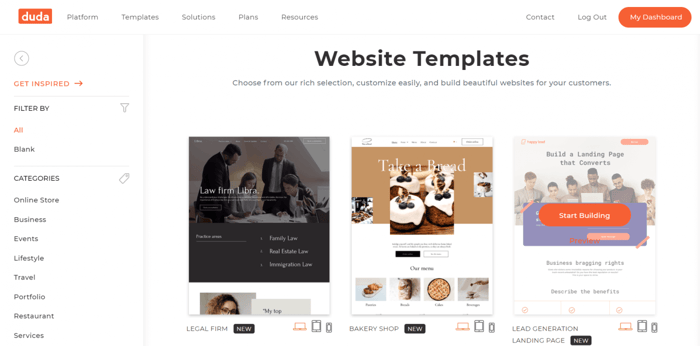
Unlike Squarespace, Duda offers blank templates for users who’d like to build their site from scratch. The same as Squarespace, once you pick a template, you can’t switch. If you want to try another template, it’ll be the same as building another site.
Customization
Duda offers more in terms of customization. It’s not just what you can do with the editor, but generally how much you can make your site stand out from the crowd and how much potential the platform has to give you exactly what you want.
Squarespace
Squarespace is more limited than Duda. But, those limitations are there for a reason.
If a company decides to make its software the easiest possible to use, it will intentionally set boundaries on what users can do. Generally, the easier to use a platform is, the fewer possibilities it’ll offer because more options mean greater complexity.
Since Squarespace mainly caters to small businesses and ordinary users, simplicity is one of its imperatives – hence, fewer customization options.
But keep in mind that if you want to go beyond the drag-and-drop editor and extend the platform’s capacities, Squarespace lets you do that through coding. You can add code the same way you add a new element and modify the page.
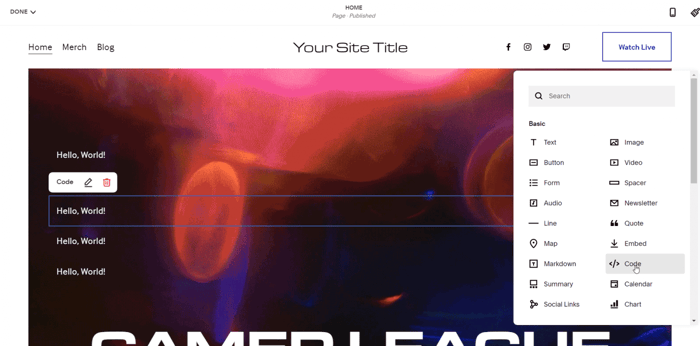
Squarespace used to provide a developer mode option, but it’s no longer available. Instead, by clicking “Settings” and going to “Advanced” you get access to possibilities like code injection that lets you inject code into a page header or footer. This option is only available with a subscription to a business & commerce plan, but it’s good to know that it’s there.
Another more powerful option is to use the Squarespace Developer Platform, which is meant to be used by developers, and build completely custom websites as well as enable integration with third-party software. For more information on this, have a look at the Squarespace Developers page.
A big advantage of Squarespace is that it provides a mobile app that lets you customize your site almost to the same level as you’d be able to do from a desktop.
Duda
As was said before, Duda offers more possibilities and functionalities, which regular users may even find a bit overwhelming.
For starters, Duda offers more out-of-the-box options. In addition to this, users get access to the developer mode that enables them to modify the existing HTML and CSS code or write their custom code.
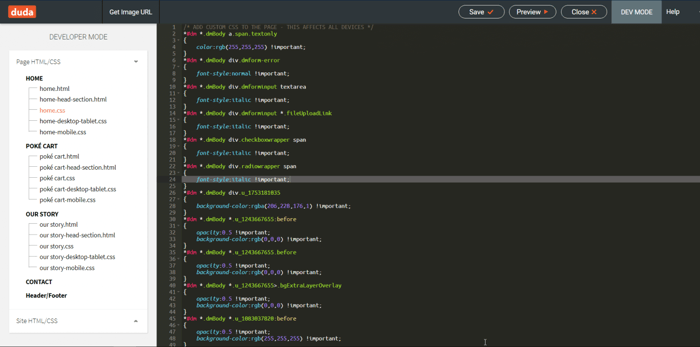
There are even more advanced options for endless customization, like a REST API, the Duda widget builder, and a JavaScript API. Check out the Developer Portal where you’ll find links to resources that’ll help you learn more about the advanced customization possibilities Duda offers.
Duda hasn’t built a mobile app yet, but it provides you with the opportunity to edit your website on a mobile device too. To be able to do this, you need to access your site from the web browser that you use on your mobile device. However, the scope of changes you can do is not as extensive as on a desktop.
In addition to this, Duda lets you edit and customize your site on your tablet.
Extensions
Squarespace
Neither one of the platforms offers a large number of extensions. There are over twenty extensions listed on the Squarespace extension page and about a dozen apps in the Duda App Store.
Squarespace offers extensions for shipping & fulfillment, finance, inventory & products, and sales & marketing. Some of the available apps are Smart SEO, ShipStation, and QuickBooks Online.
Duda
The Duda App Store includes Site Search 360, Usercentrics, Agendize, and other apps. Some of them offer a free plan or a free trial.
Duda allows you to add third-party software through embed codes as well. For example, you can add a superb blogging app like DropInBlog using this method. Duda includes a built-in blog, but it’s far from being the powerful and fully-fledged blogging solution that many users would need. By embedding a few lines of code into your Duda website, you can enjoy the benefits of a state-of-the-art blog on Duda. The beauty of it is that it’s a pretty quick and simple way of extending your Duda website.
It’s worth noting that Squarespace too allows for adding third-party software through an embed code.
Pricing
Squarespace
Squarespace offers four pricing plans which are billed monthly or manually. With an annual subscription, Squarespace gives a 25% to 30% discount. The plans are really simple, and this is how much they cost (billed monthly):
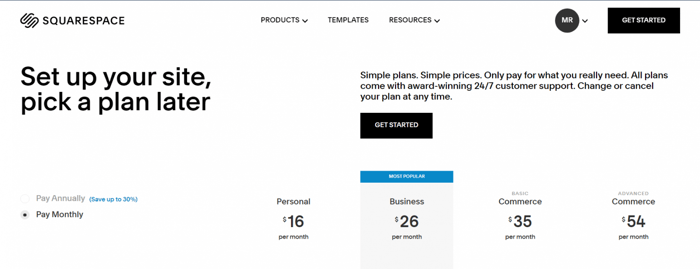
Every plan includes a free custom domain, unlimited bandwidth & storage, SSL encryption, and SEO tools.
The advantage of the business and commerce plans is that they include more advanced customization options, as well as e-commerce features like the ability to sell unlimited products, accept donations, give gift cards, use a point-of-sale system, use abandoned cart recovery, sell subscriptions to your clients, etc.
Naturally, the higher you go up the price ladder, the more advanced features you get.
Duda
Duda has a similarly structured pricing system: four pricing plans, three of which are regular and one custom, and two types of subscription – monthly and annual – the perk of the second being the 25% discount. This is a summary of the Duda pricing plans:

But there’s more. On top of these plans, there are e-commerce add-ons:
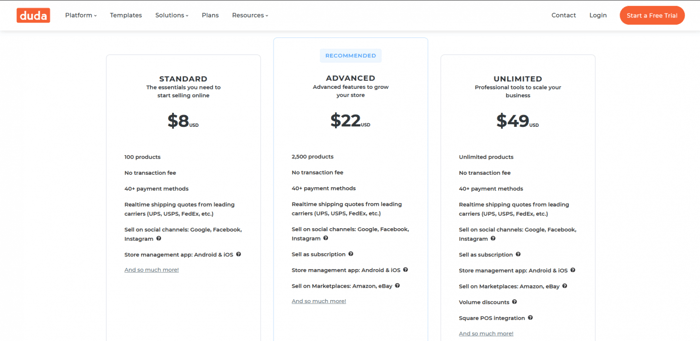
There’s a discount on the annual subscription to the e-commerce add-ons, so if you decide to pay up front for a whole year, the prices are $7.25/month, $19.25/month, and $39/month.
-commerce add-ons, you get access to more than 40 payment gateways, coupons & gift cards, multi-channel sales, inventory tracking, and a lot more.
It’s clear from their name that they’re not full-blown pricing plans, so you pay the fee on top of the plan that you’re subscribed to.
The Duda pricing system is more complex, which may not be the most convenient thing, but on the other hand, it gives you more opportunities compared to Squarespace. Again, it’s up to the users whether they prefer more choice with some complexity or simplicity with less choice.
Support
Squarespace
The Squarespace customer service staff is known for being polite, quick to reply, and able to provide extremely helpful answers, tips, and suggestions.
The company provides support in many ways: email (24/7), a chatbot, a live chat (business days, from 4 a.m. to 8 p.m. EST), a help page, Twitter, and more.
Duda
The Duda customer service holds high ratings and its customers report having overwhelmingly positive experiences with the support staff.
Duda too has got your back via various channels: email, chat, phone, 24/7 dedicated support with the Custom plan, a support page, the Duda University, the Duda Blog, and others.
Over and Out
In this Duda vs. Squarespace comparison, we only scratched the surface of what these two platforms offer. There’s so much more that can be written and learned about them. However, we hope that even this overview will be sufficient to help readers in their search for the most adequate platform for their business.




